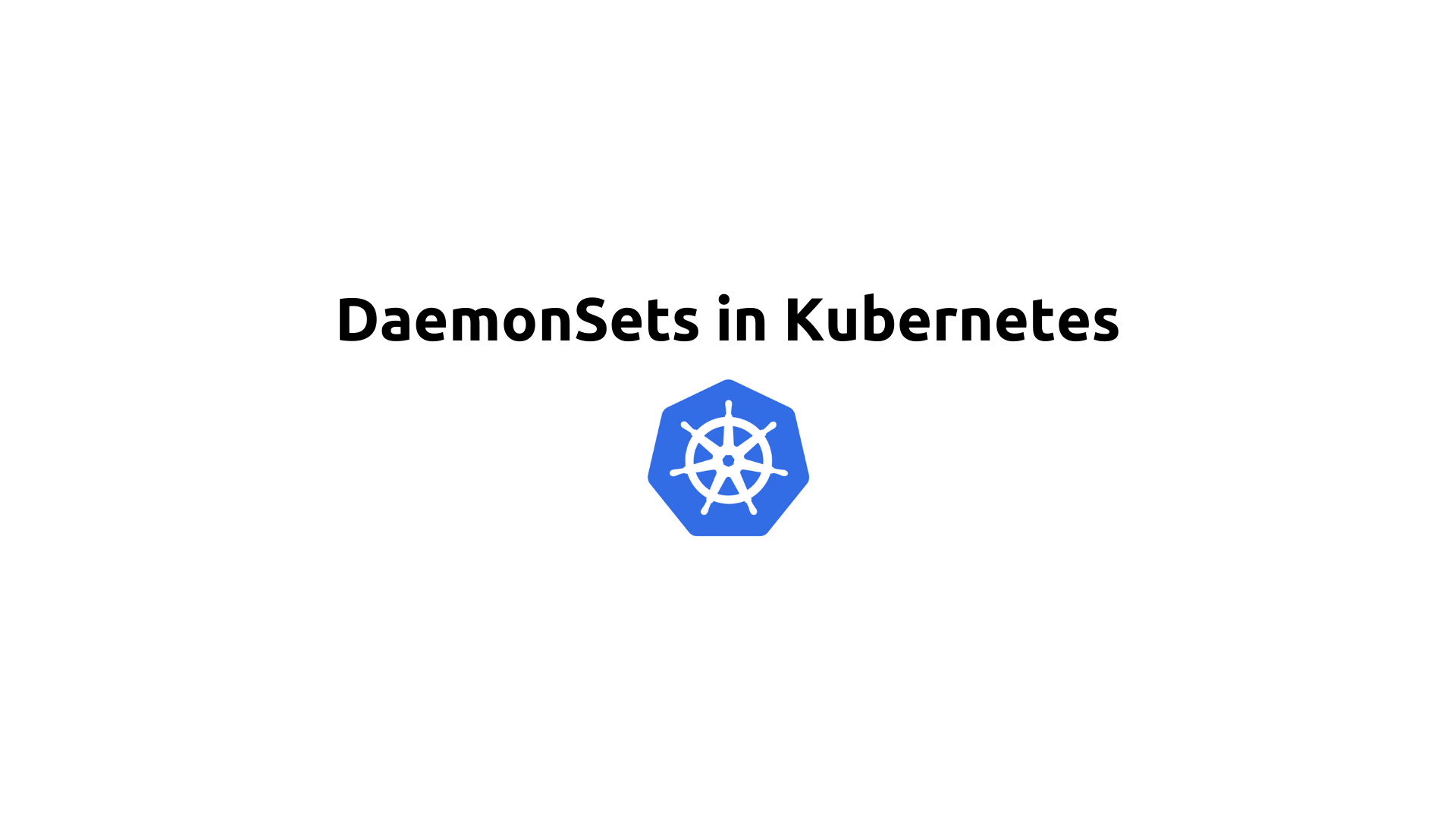DaemonSets in Kubernetes
 Saurabh Adhau
Saurabh Adhau
Introduction
Kubernetes offers a variety of resource types to manage different workloads and use cases. One such resource type is DaemonSet, which ensures that a copy of a specific pod runs on all or selected nodes in a cluster. This article explores DaemonSets, their benefits, use cases, and provides practical examples.
What is a DaemonSet?
A DaemonSet is a Kubernetes resource that ensures a specified pod runs on all (or some) nodes in a cluster. Whenever a new node is added to the cluster, the DaemonSet automatically deploys a pod on that node. Conversely, when a node is removed from the cluster, the DaemonSet ensures that the corresponding pod is also removed.
Key Features of DaemonSets
Uniform Deployment: Ensures that all or selected nodes run the specified pods.
Automated Management: Automatically handles pod deployment on node addition and removal.
Configuration Consistency: Ensures consistent configuration and behavior across all nodes.
Pros of Using DaemonSets
Simplified Management: Automates the deployment and management of pods across nodes.
Consistency: Ensures that all nodes have the necessary components for monitoring, logging, or other node-specific tasks.
Scalability: Automatically handles pods on newly added nodes without manual intervention.
Resource Efficiency: Efficiently manages node-level workloads without the need for separate deployment configurations.
Use Cases for DaemonSets
DaemonSets are ideal for scenarios where certain tasks or services need to be present on all or specific nodes, such as:
Logging: Deploying log collectors like Fluentd or Logstash to gather logs from all nodes.
Monitoring: Running monitoring agents like Prometheus Node Exporter or Datadog Agent on each node.
Networking: Ensuring network components like Calico or Weave Net are present on all nodes.
Security: Deploying security agents or tools like Falco or antivirus solutions on each node.
Practical Examples of DaemonSets
Example 1: Deploying Fluentd for Logging
Fluentd is a popular log collector used to gather and forward logs. Here's how to deploy Fluentd using a DaemonSet.
apiVersion: apps/v1
kind: DaemonSet
metadata:
name: fluentd
labels:
app: fluentd
spec:
selector:
matchLabels:
name: fluentd
template:
metadata:
labels:
name: fluentd
spec:
containers:
- name: fluentd
image: fluent/fluentd:v1.11
resources:
limits:
memory: 200Mi
cpu: 0.5
requests:
memory: 100Mi
cpu: 0.2
volumeMounts:
- name: varlog
mountPath: /var/log
- name: varlibdockercontainers
mountPath: /var/lib/docker/containers
readOnly: true
terminationGracePeriodSeconds: 30
volumes:
- name: varlog
hostPath:
path: /var/log
- name: varlibdockercontainers
hostPath:
path: /var/lib/docker/containers
Deploy the DaemonSet using:
kubectl apply -f fluentd-daemonset.yaml
Example 2: Deploying Prometheus Node Exporter for Monitoring
Prometheus Node Exporter collects and exposes hardware and OS metrics. Here's how to deploy it using a DaemonSet.
apiVersion: apps/v1
kind: DaemonSet
metadata:
name: node-exporter
labels:
app: node-exporter
spec:
selector:
matchLabels:
app: node-exporter
template:
metadata:
labels:
app: node-exporter
spec:
containers:
- name: node-exporter
image: prom/node-exporter:v1.1.2
ports:
- containerPort: 9100
name: metrics
resources:
requests:
memory: 30Mi
cpu: 100m
limits:
memory: 50Mi
cpu: 200m
volumes:
- name: proc
hostPath:
path: /proc
type: Directory
- name: sys
hostPath:
path: /sys
type: Directory
- name: root
hostPath:
path: /
type: Directory
mountPropagation: HostToContainer
containers:
- name: node-exporter
image: prom/node-exporter:v1.1.2
volumeMounts:
- name: proc
mountPath: /host/proc
readOnly: true
- name: sys
mountPath: /host/sys
readOnly: true
- name: root
mountPath: /rootfs
readOnly: true
securityContext:
runAsUser: 65534
procMount: Default
args:
- '--path.procfs=/host/proc'
- '--path.sysfs=/host/sys'
- '--collector.filesystem.ignored-mount-points="^/(sys|proc|dev|host|etc)($$|/)"'
Deploy the DaemonSet using:
kubectl apply -f node-exporter-daemonset.yaml
Example 3: Deploying Calico for Networking
Calico is a popular network plugin for Kubernetes. Here's how to deploy it using a DaemonSet.
apiVersion: apps/v1
kind: DaemonSet
metadata:
name: calico-node
namespace: kube-system
labels:
k8s-app: calico-node
spec:
selector:
matchLabels:
k8s-app: calico-node
template:
metadata:
labels:
k8s-app: calico-node
spec:
hostNetwork: true
containers:
- name: calico-node
image: calico/node:v3.17.2
env:
- name: DATASTORE_TYPE
value: "kubernetes"
- name: CALICO_NETWORKING_BACKEND
value: "bird"
- name: CLUSTER_TYPE
value: "k8s,bgp"
- name: IP
value: "autodetect"
- name: CALICO_IPV4POOL_CIDR
value: "192.168.0.0/16"
- name: FELIX_IPINIPMTU
value: "1440"
- name: CALICO_IPV4POOL_IPIP
value: "Always"
securityContext:
privileged: true
volumeMounts:
- mountPath: /var/run/calico
name: var-run-calico
- mountPath: /lib/modules
name: lib-modules
readOnly: true
volumes:
- name: var-run-calico
hostPath:
path: /var/run/calico
- name: lib-modules
hostPath:
path: /lib/modules
Deploy the DaemonSet using:
kubectl apply -f calico-daemonset.yaml
Conclusion
DaemonSets in Kubernetes provide an efficient way to ensure that specific pods run on all or selected nodes, offering automated management, consistency, and scalability. They are particularly useful for deploying logging, monitoring, networking, and security agents across all nodes. The practical examples provided demonstrate how to deploy Fluentd, Prometheus Node Exporter, and Calico using DaemonSets, highlighting their effectiveness in managing node-level workloads in Kubernetes. Understanding and leveraging DaemonSets can significantly enhance the management and operation of your Kubernetes cluster.
Subscribe to my newsletter
Read articles from Saurabh Adhau directly inside your inbox. Subscribe to the newsletter, and don't miss out.
Written by

Saurabh Adhau
Saurabh Adhau
As a DevOps Engineer, I thrive in the cloud and command a vast arsenal of tools and technologies: ☁️ AWS and Azure Cloud: Where the sky is the limit, I ensure applications soar. 🔨 DevOps Toolbelt: Git, GitHub, GitLab – I master them all for smooth development workflows. 🧱 Infrastructure as Code: Terraform and Ansible sculpt infrastructure like a masterpiece. 🐳 Containerization: With Docker, I package applications for effortless deployment. 🚀 Orchestration: Kubernetes conducts my application symphonies. 🌐 Web Servers: Nginx and Apache, my trusted gatekeepers of the web.